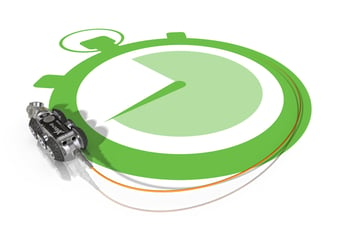Crawler inspections can be conducted in a number of different ways, but all serve the same purpose: to assess the condition of a pipe. Because there is little we can find out about a pipe’s condition from above ground, utilizing technology to gather insight underground is essential. 
By getting eyes underground, operators can determine whether a pipe is in good condition or if it’s in need of repairs, rehabilitation or a complete replacement by identifying cracks, roots, blockages, leaks, corrosion and more. Without inspections, defects in sewer pipes can go unnoticed and can lead to I&I and major consequences like contamination and collapses, creating risk to the surrounding wastewater infrastructure and the communities it services.
Average Timing
The most common way to inspect sewers is by using a robotic CCTV camera crawler. This allows operators to visually navigate through the pipe from above ground, identifying needs in real-time and creating reports based on observations. So how long does it take to perform a sewer inspection?
Inspections are typically carried out from manhole to manhole, which is roughly 300 feet. Depending on a number of variables, an inspection from one manhole to the next takes approximately 20-30 minutes on average. Put into perspective, contractors typically aim to inspect between 2,500 and 3,000 feet per day.
Variance From One Inspection to the Next
Inspection time differs greatly due to variables like pipe size, length and configuration. And the worse the condition of the pipe, the longer the inspection will take, mainly due to the operator stopping more frequently to look closer at defects.
Inspection time also varies depending on the type of inspection being performed. For a thorough NASSCO PACP Standards report, the operator will stop at every defect and lateral to closely analyze, requiring more inspection time. For a quick follow-up inspection to verify a repair or cleaning job, significantly less time is required.
Inspection Process
With each inspection also comes the process of set up and take down. While not required, it’s highly recommended the pipe is cleaned beforehand to optimize the inspection for faster navigation and clearer views. Once the pipe is cleaned, equipment set up can be relatively quick—approximately 10-20 minutes.
Operators should first power up the system and test it above ground to ensure it’s functioning properly before sending it down. The crawler is then also set up with wheels based on the pipe size and material, and any accessories needed, like a lift, carriage or auxiliary lights. Once ready, it can be lowered into the manhole and begin inspecting, using features like pan/tilt and zoom to provide operators with optimal views so that no issue goes unnoticed.
Optimizing with Equipment
There is no one-size-fits-all inspection. The process can vary depending on equipment used, inspection requirements, pipe size and quality, and more.
But with features like quick-change wheels on Envirosight’s ROVVER X sewer inspection crawler, productivity on-site can be maximized, giving operators the ability to change wheels as needed in just minutes without tools, saving a lot of time. The more flexibility offered in the equipment, the more operators can do at once.
To learn about the ROVVER X, schedule a free on-site demo today:

